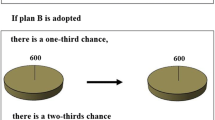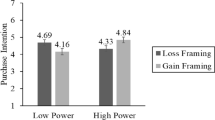Abstract
A review of previous literature shows that there are at least three ways in which regulatory focus may be related to message framing. Specifically, persuasion might be enhanced when there is a match between a person’s regulatory focus and (a) the outcome focus of the message (i.e., gain vs. loss anchor); (b) the overall valence of the message (i.e., positive vs. negative valence); and (c) the type of benefit or harm emphasized (i.e., achievement vs. security). In an effort to explicitly compare and contrast these three possibilities, and to determine whether the results depend on the way regulatory focus is measured, we used a 2 (outcome focus) by 2 (overall valence) by 2 (type of benefit or harm emphasized) within-subjects factorial design and three commonly employed measures of regulatory focus to test the three accounts. The findings were most consistent with the hypothesis that the perceived persuasiveness of a message is increased when there is a match between a person’s chronic regulatory focus and the overall valence of the message.
Similar content being viewed by others
References
Apanovitch, A. M., McCarthy, D. E., & Salovey, P. (2003). Using message framing to motivate HIV testing among low-income, ethnic minority women. Health Psychology, 22, 60–67.
Brendl, C. M., Higgins, E. T., & Lemm, K. M. (1995). Sensitivity to varying gains and losses: The role of self-discrepancies and event framing. Journal of Personality and Social Psychology, 69, 1028–1051.
Carver, C. S., & Scheier, M. F. (1999). Themes and issues in the self-regulation of behavior. In R. S. Wyer Jr. (Ed.), Advances in social cognition (Vol. 7, pp. 1–105). New York: Academy Press.
Carver, C. S., & White, T. L. (1994). Behavioral inhibition, behavioral activation, and affective responses to impending reward and punishment: The BIS/BAS scales. Journal of Personality and Social Psychology, 67, 319–333.
Cesario, J., Grant, H., & Higgins, E. T. (2004). Regulatory fit and persuasion: Transfer from “feeling right”. Journal of Personality and Social Psychology, 86, 388–404.
Crowe, E., & Higgins, E. T. (1997). Regulatory focus and strategic inclinations: Promotion and prevention in decision making. Organizational Behavior and Human Decision Processes, 69, 117–132.
Detweiler, J. B., Bedell, B. T., Salovey, P., Pronin, E., & Rothman, A. J. (1999). Message framing and sunscreen use: Gain-framed messages motivate beach-goers. Health Psychology, 18, 189–196.
Dholakia, U. M., Bagozzi, R. P., & Nataraajan, R. (2006). To buy or not to buy: The role of regulatory focus in the experience and self-control of desire for temptations. Journal of Consumer Psychology, 16, 163–175.
Higgins, E. T. (1996). Knowledge activation: Accessibility, applicability, and salience. In E. T. Higgins & A. W. Kruglanski (Eds.), Social psychology: Handbook of basic principles (pp. 133–168). New York: Guilford Press.
Higgins, E. T. (1998). Promotion and prevention: Regulatory focus as a motivational principle. In M. P. Zanna (Ed.), Advances in experimental social psychology (Vol. 30, pp. 1–46). New York: Academic Press.
Higgins, E. T., Friedman, R. S., Harlow, R. E., Idson, L. C., Ayduk, O. N., & Taylor, A. (2001). Achievement orientations from subjective histories of success: Promotion pride versus prevention pride. European Journal of Social Psychology, 31, 3–23.
Higgins, E. T., Klein, R., & Strauman, T. (1985). Self-concept discrepancy theory: A psychological model for distinguishing among different aspects of depression and anxiety. Social Cognition, 3, 51–76.
Higgins, E. T., & Tykocinski, O. (1992). Self-discrepancies and biographical memory: Personality and cognition at the level of psychological situation. Personality and Social Psychology Bulletin, 18, 527–535.
Idson, L. C., Liberman, N., & Higgins, E. T. (2000). Distinguishing gains from nonlosses and losses from nongains: A regulatory focus perspective on hedonic intensity. Journal of Experimental Social Psychology, 36, 252–274.
Lee, A. Y., & Aaker, J. L. (2004). Bringing the frame into focus: The influence of regulatory fit on processing fluency and persuasion. Journal of Personality and Social Psychology, 86, 205–518.
Leone, L., Perugini, M., & Bagozzi, R. P. (2005). Emotions and decision making: Regulatory focus moderates the influence of anticipated emotions on action evaluations. Cognition and Emotion, 19(8), 1175–1198.
Levin, I. P., Gaeth, G., Schreiber, J., & Lauriola, M. (2002). A new look at framing effects: Distribution of effect sizes, individual differences, and independence of types of effects. Organizational Behavior and Human Decision Processes, 88(1), 411–429.
Levin, I. P., Schneider, S. L., & Gaeth, G. J. (1998). All frames are not created equal: A typology and critical analysis of framing effects. Organizational Behavior and Human Decision Processes, 76, 149–188.
Lockwood, P., Jordan, C. H., & Kunda, Z. (2002). Motivation by positive or negative role models: Regulatory focus determines who will best inspire us. Journal of Personality and Social Psychology, 83, 854–864.
Meyerowitz, B. E., & Chaiken, S. (1987). The effect of message framing on breast self-examination attitudes, intentions, and behavior. Journal of Personality and Social Psychology, 52(3), 500–510.
O’Keefe, D. J., & Jensen, J. D. (2006). The advantages of compliance or the disadvantages of noncompliance? A meta-analytic review of the relative persuasive effectiveness of gain-framed and loss-framed messages. Communication Yearbook, 30, 1–43.
Pickering, A. D., & Gray, J. A. (1999). The neuroscience of personality. In L. Pervin & O. John (Eds.), Handbook of personality (2nd ed., pp. 277–299). New York: Guilford Press.
Rothman, A. J., & Salovey, P. (1997). Shaping perceptions to motivate healthy behavior: The role of message framing. Psychological Review, 121, 3–19.
Shah, J., Higgins, E. T., & Friedman, R. S. (1998). Performance incentives and means: How regulatory focus influences goal attainment. Journal of Personality and Social Psychology, 74, 285–293.
Spiegel, S., Grant-Pillow, H., & Higgins, E. T. (2004). How regulatory fit enhances motivational strength during goal pursuit. European Journal of Social Psychology, 34, 39–54.
Stepper, S., Strack, F., & Higgins, E. T. (1997). The memory system: A self-regulatory perspective. Unpublished manuscript, Würzburg University.
Summerville, A., & Roese, N. J. (2008). Self-report measures of individual differences in regulatory focus: A cautionary note. Journal of Research in Personality, 42, 247–254.
Author information
Authors and Affiliations
Corresponding author
Rights and permissions
About this article
Cite this article
Yi, S., Baumgartner, H. Regulatory focus and message framing: A test of three accounts. Motiv Emot 33, 435–443 (2009). https://doi.org/10.1007/s11031-009-9148-y
Published:
Issue Date:
DOI: https://doi.org/10.1007/s11031-009-9148-y




